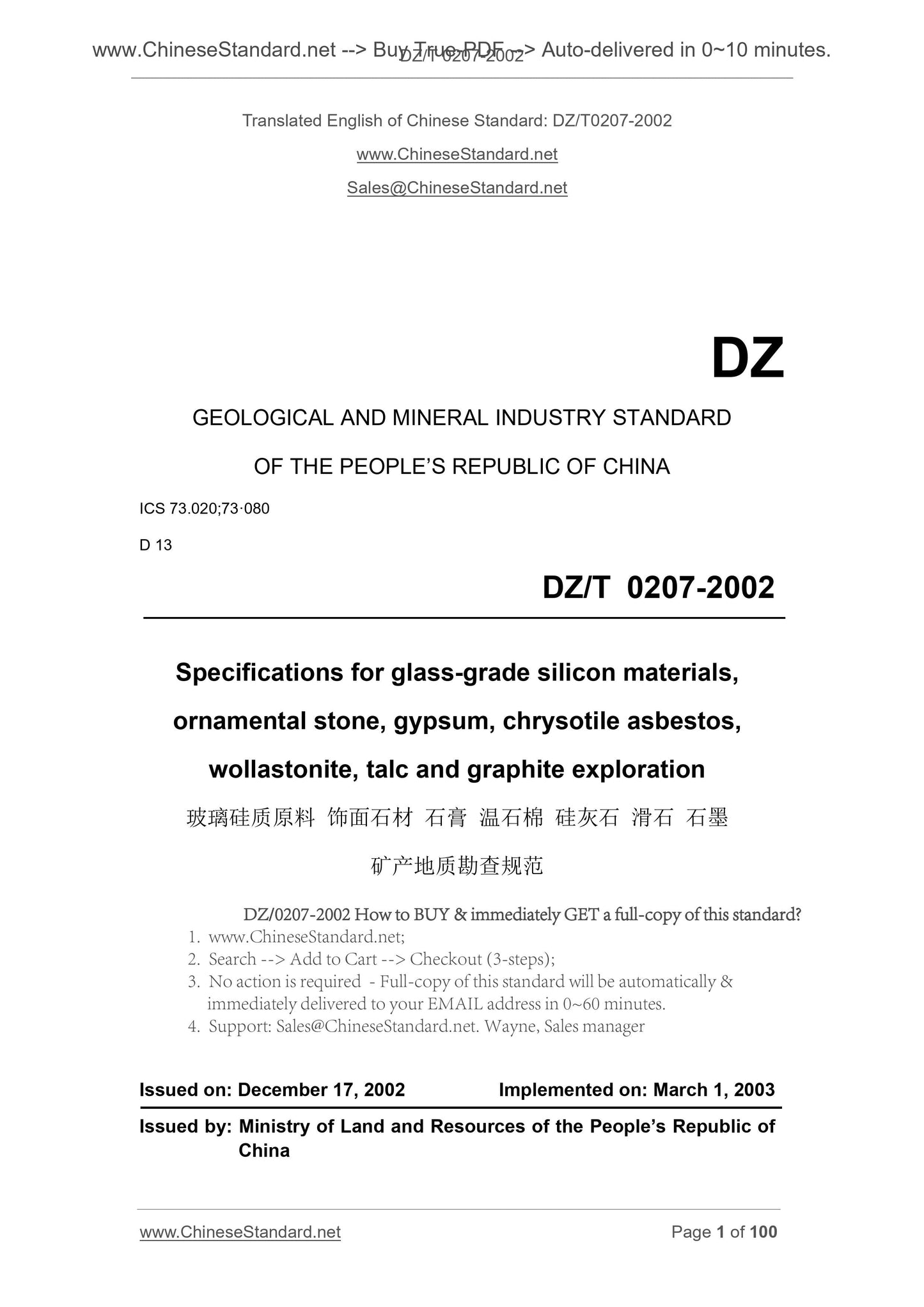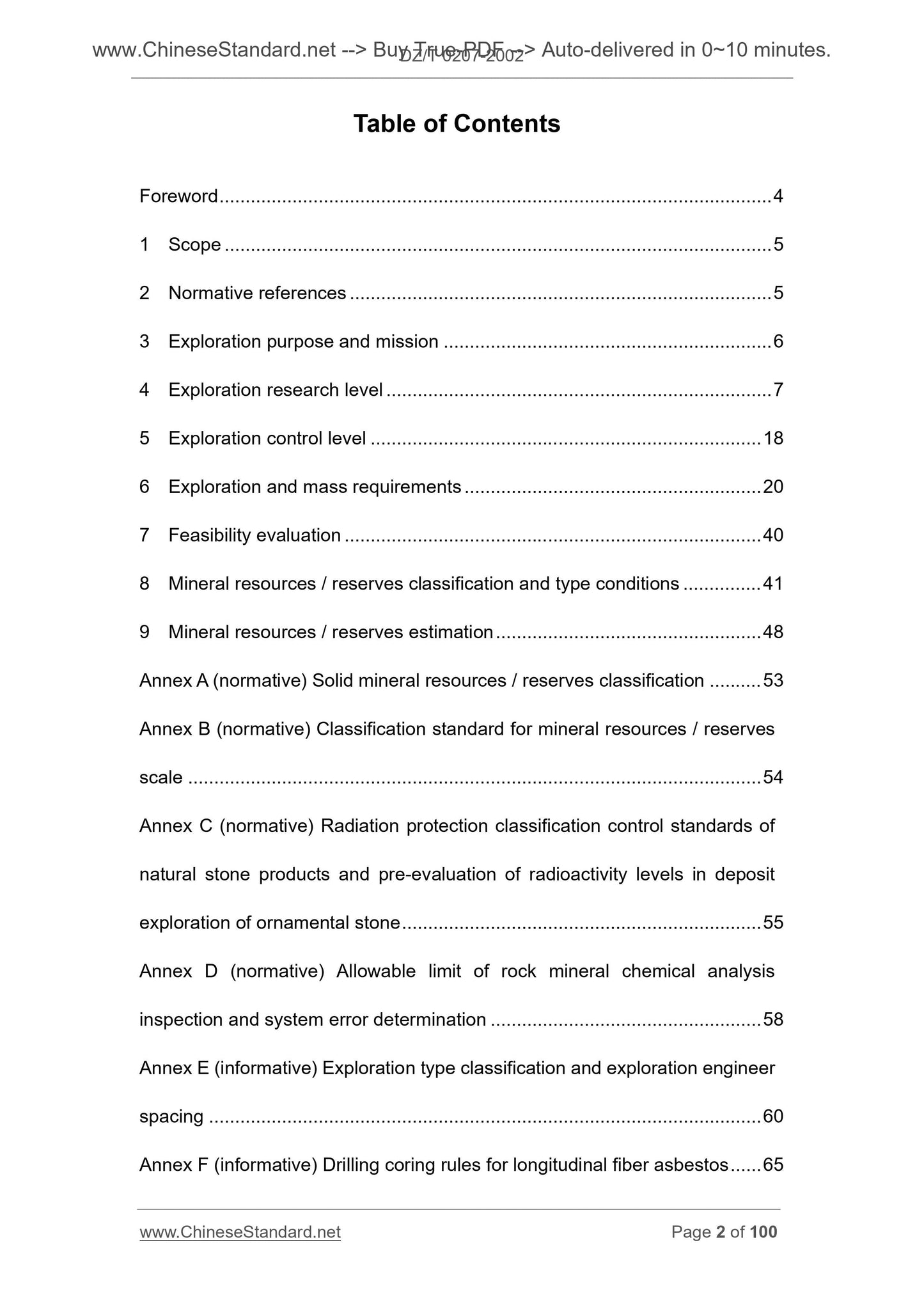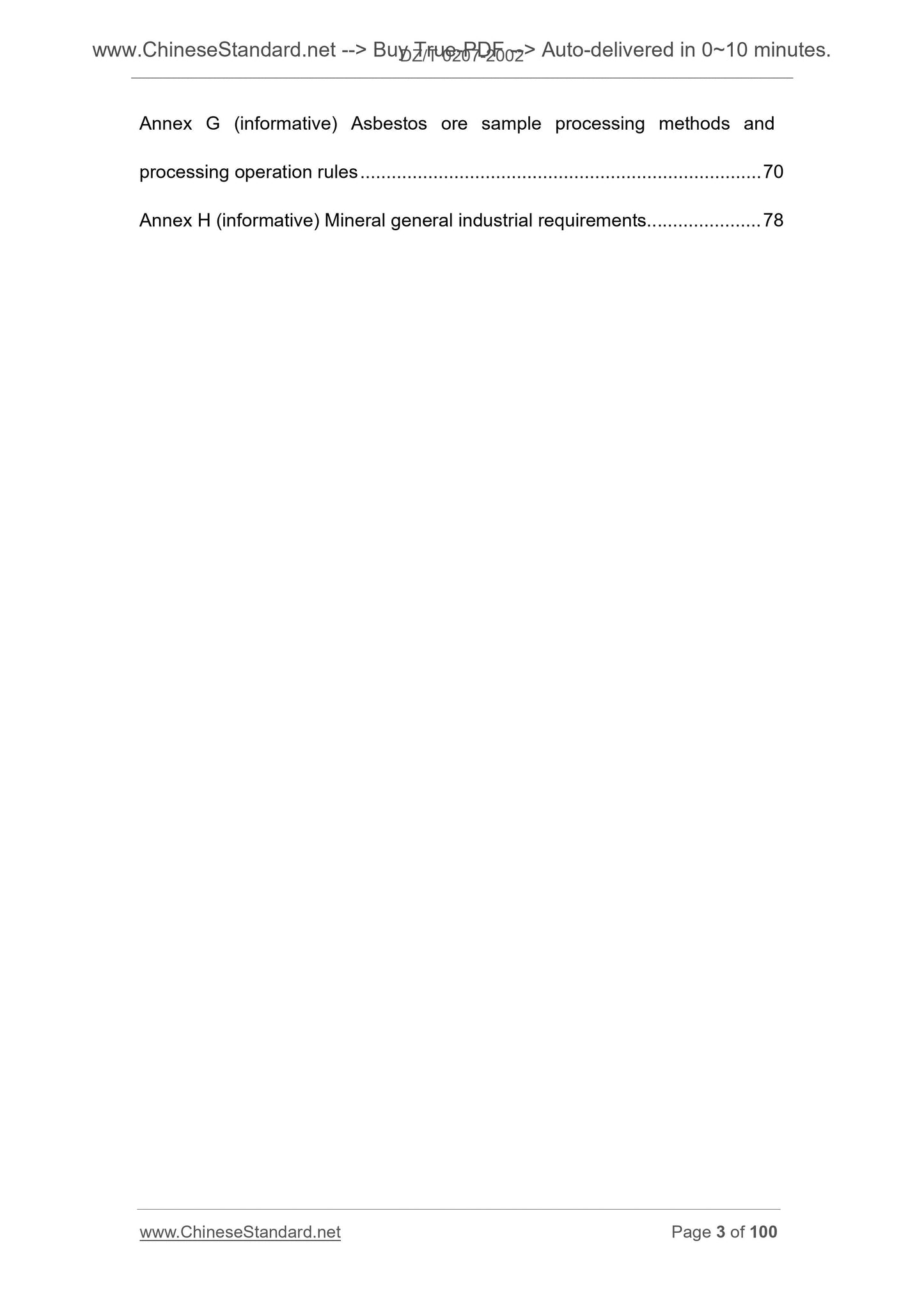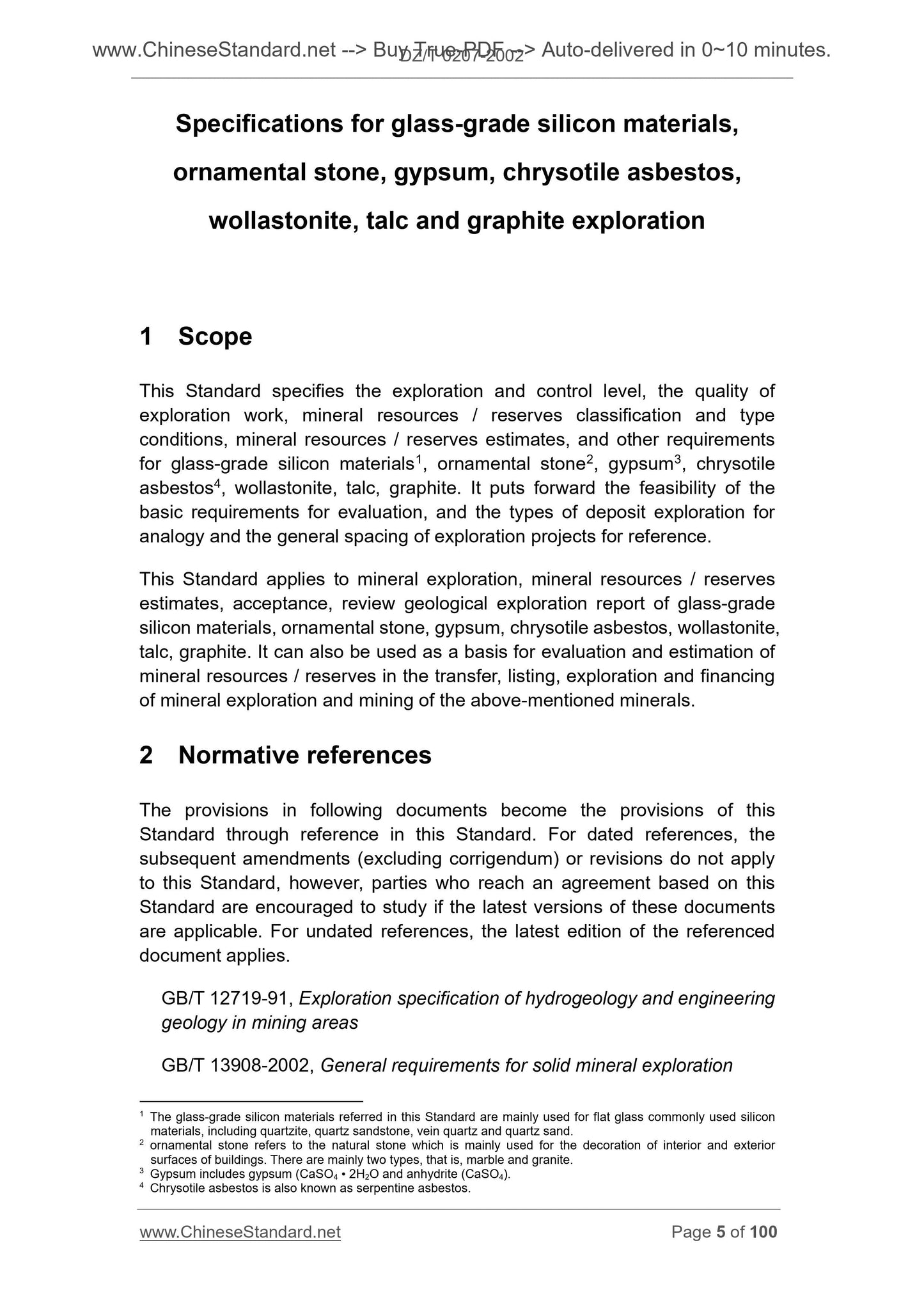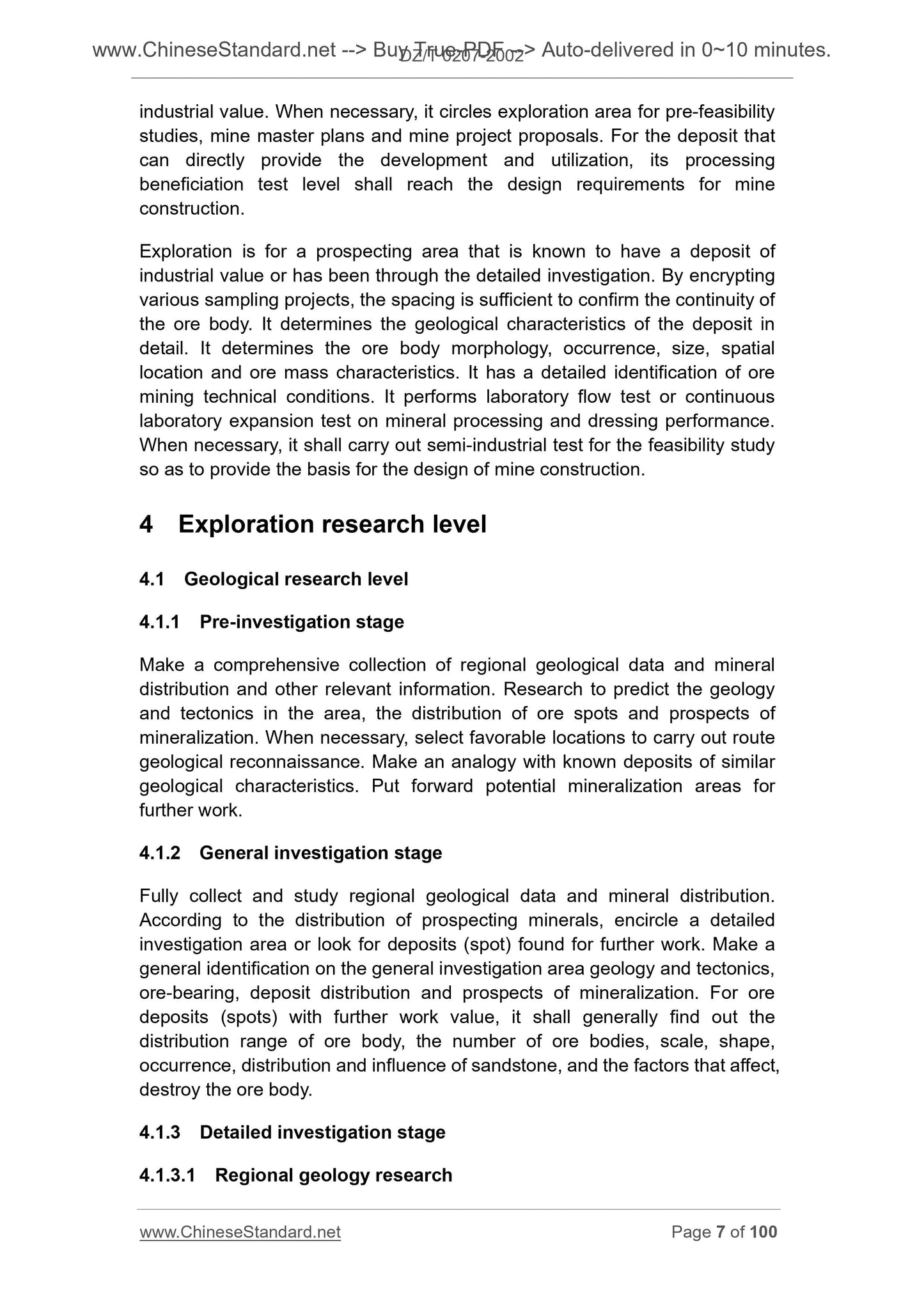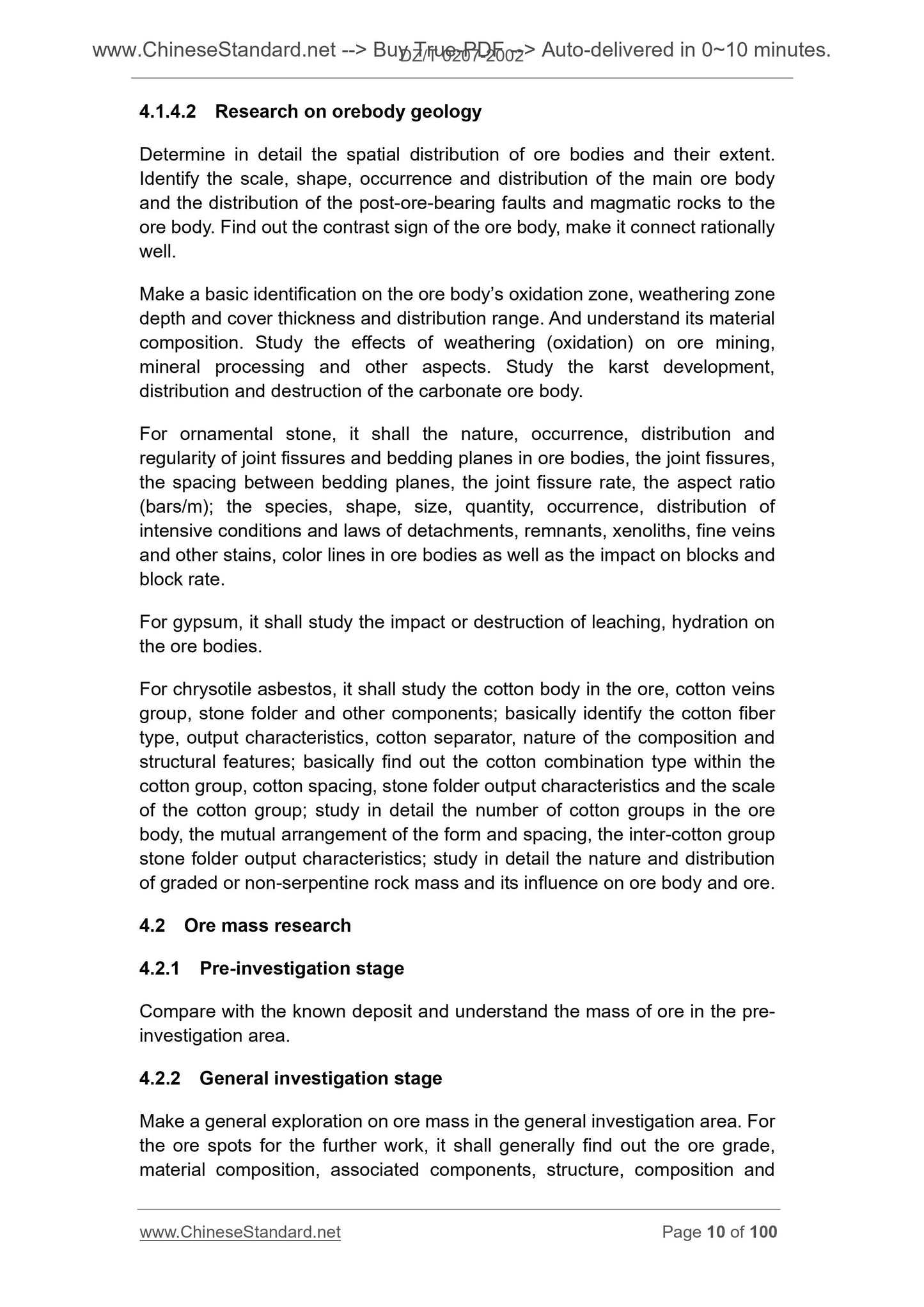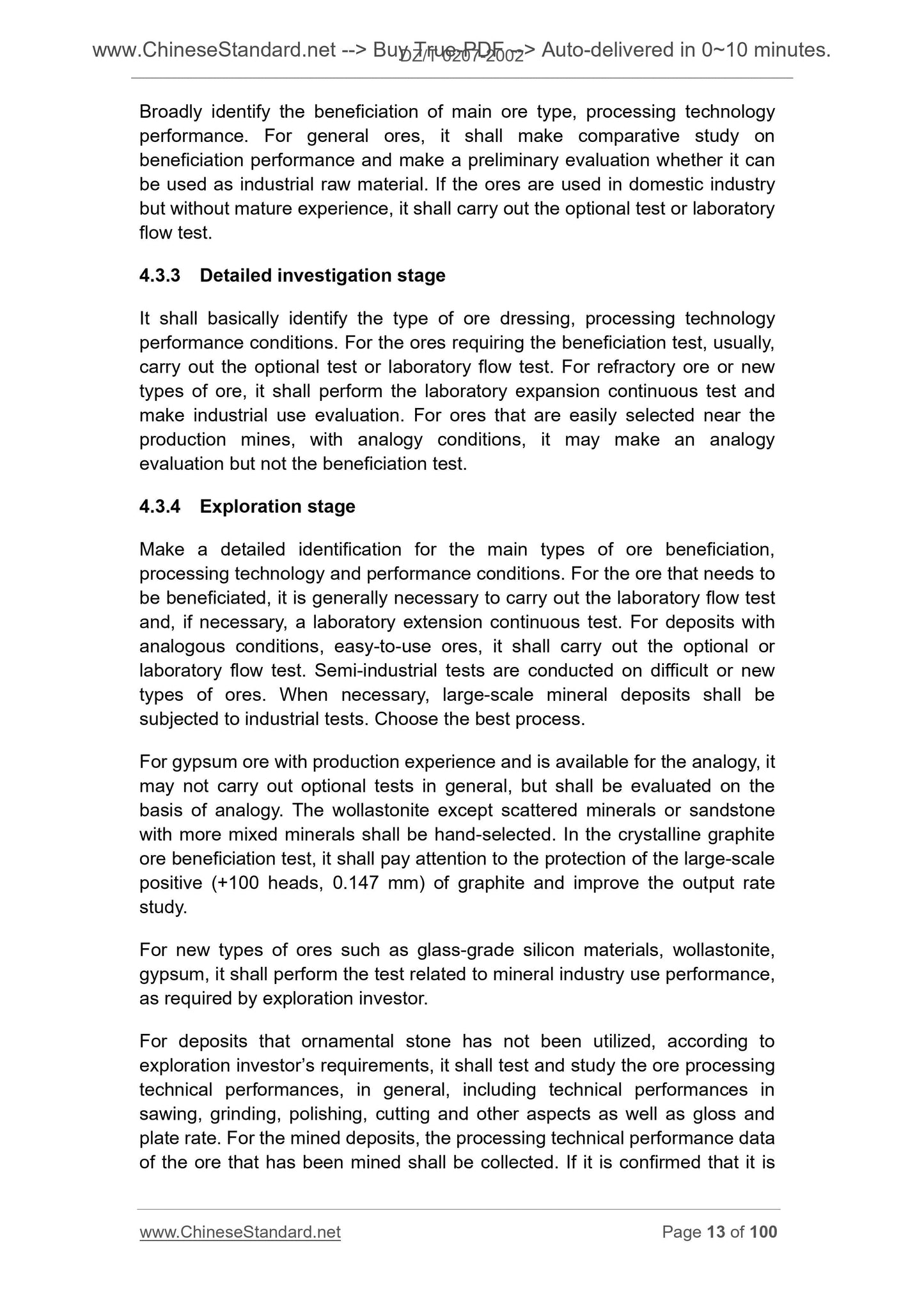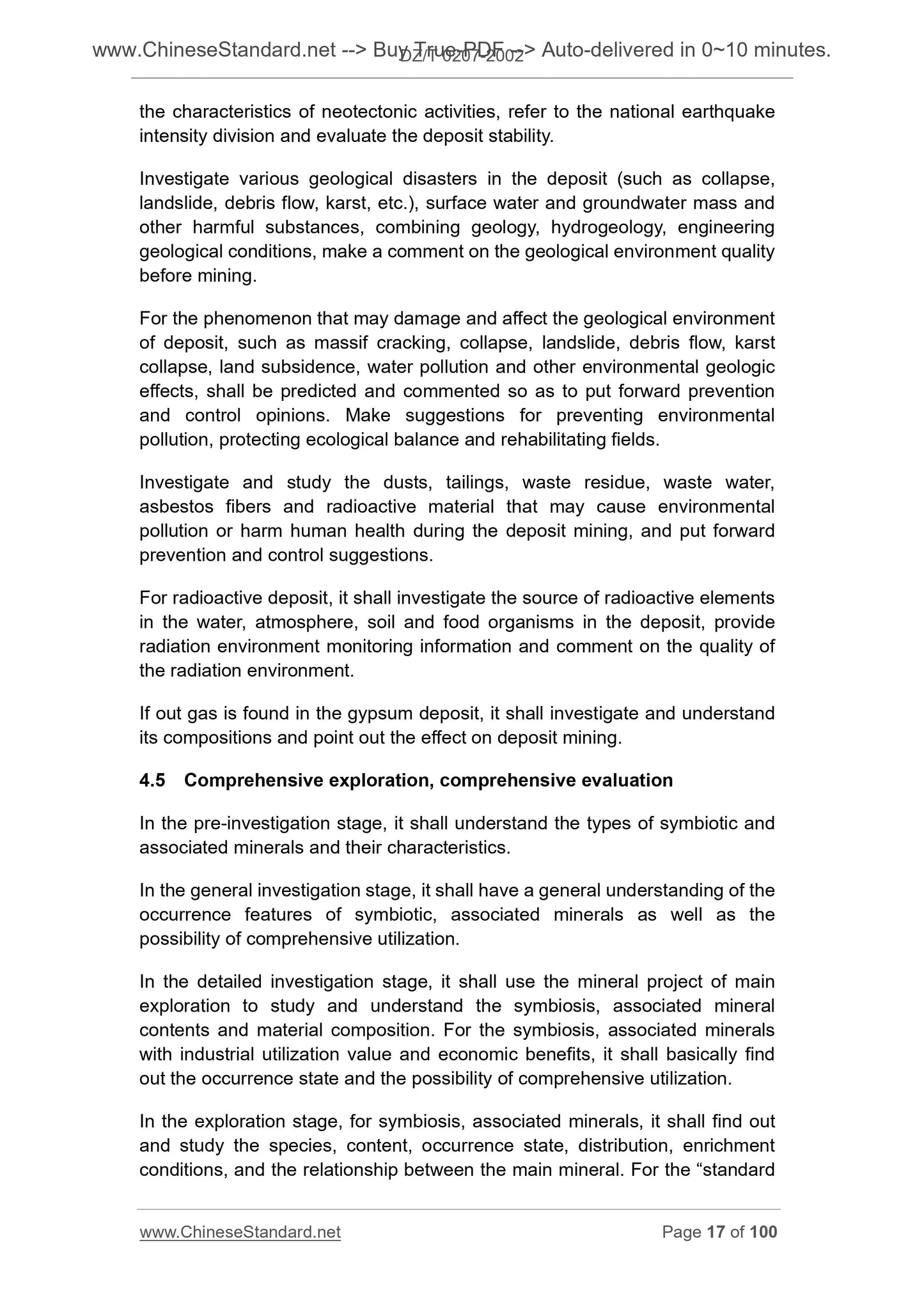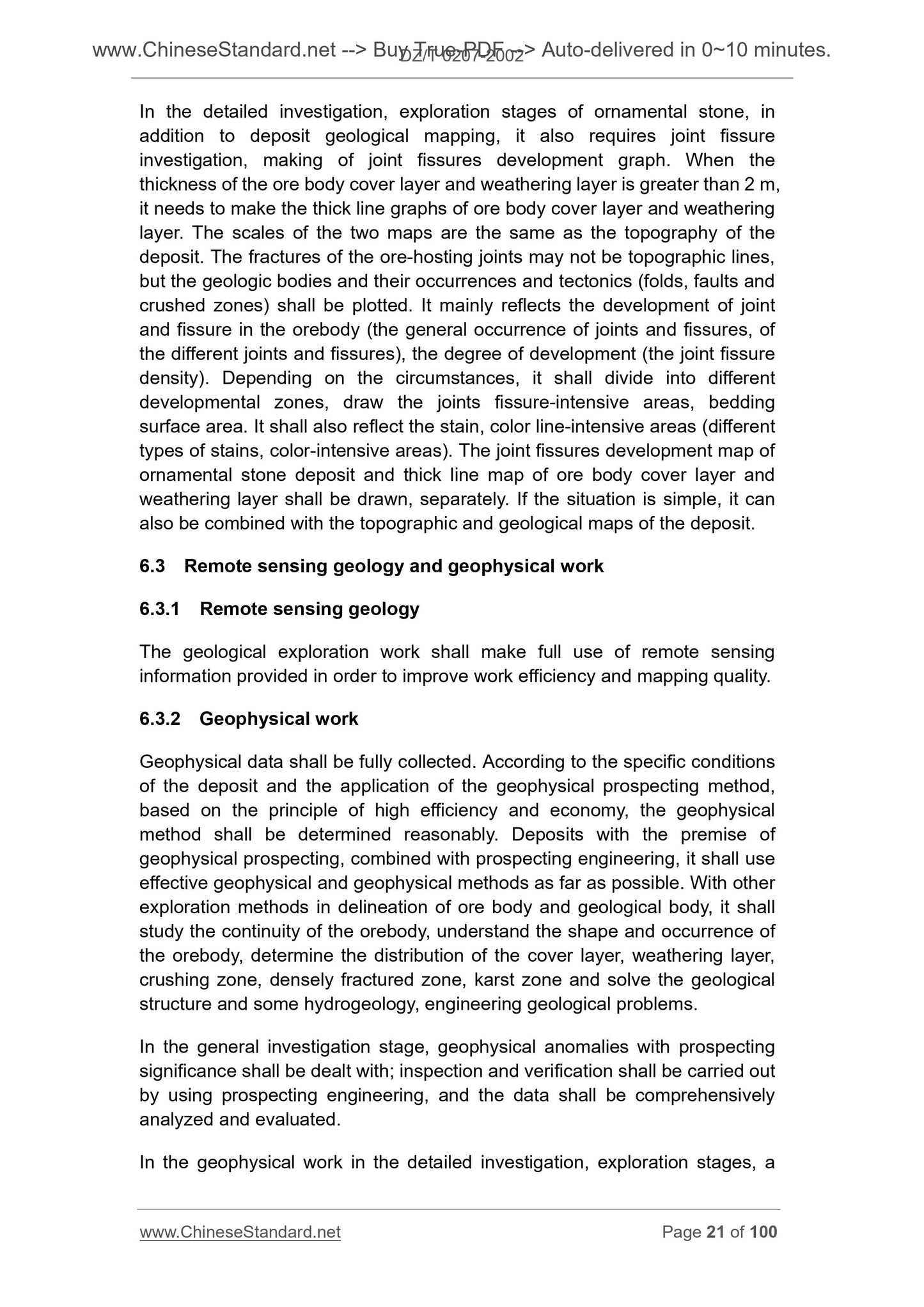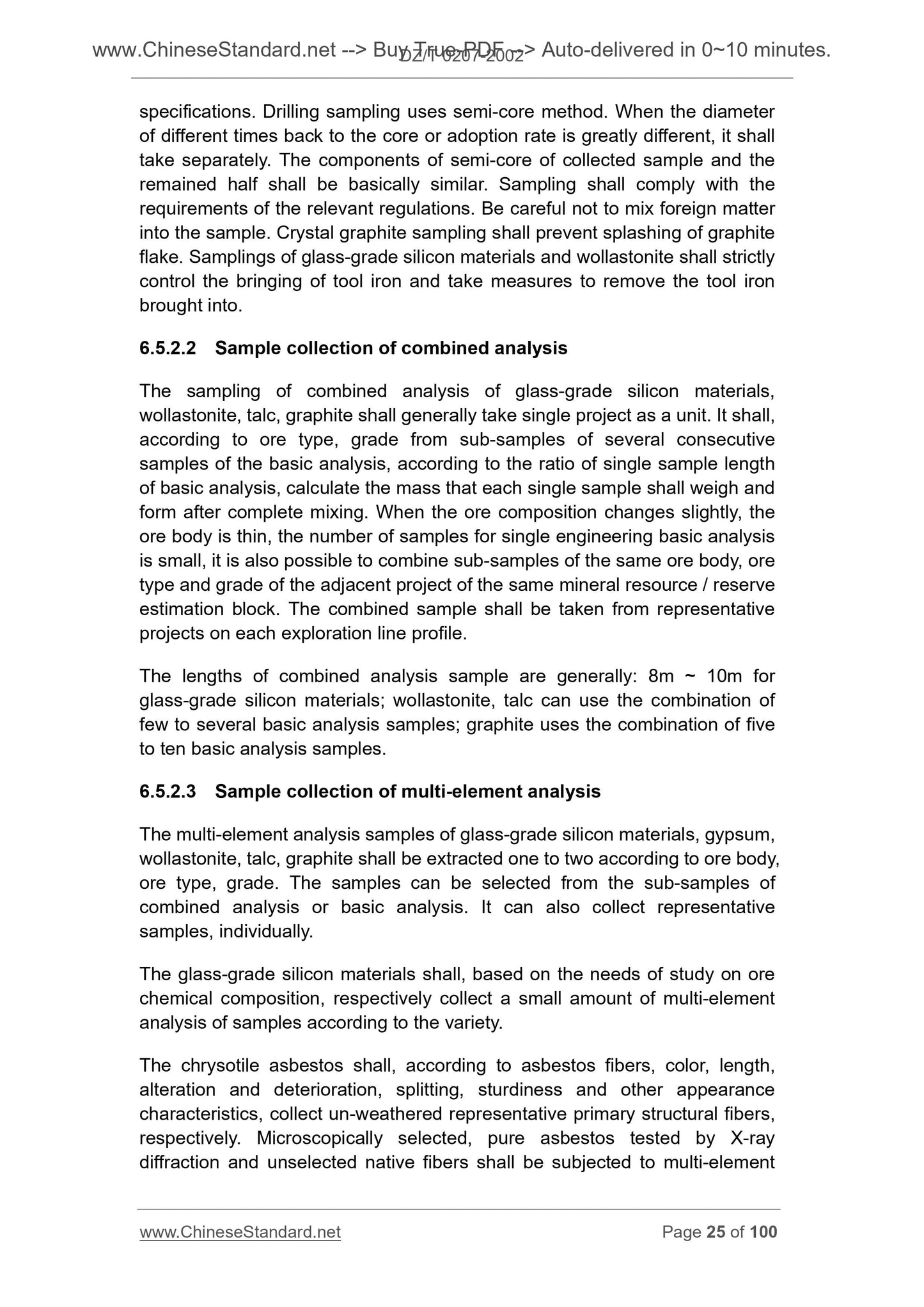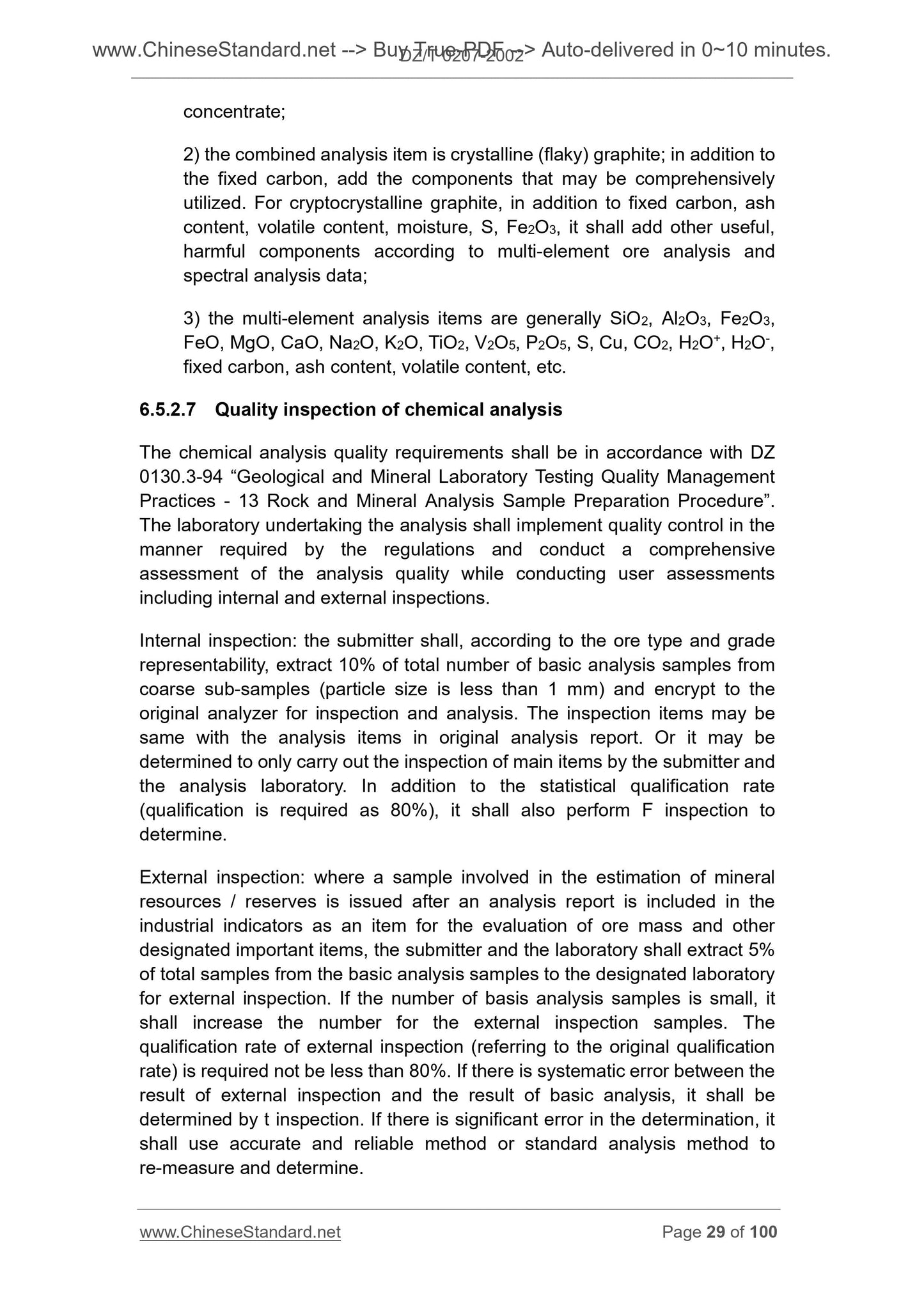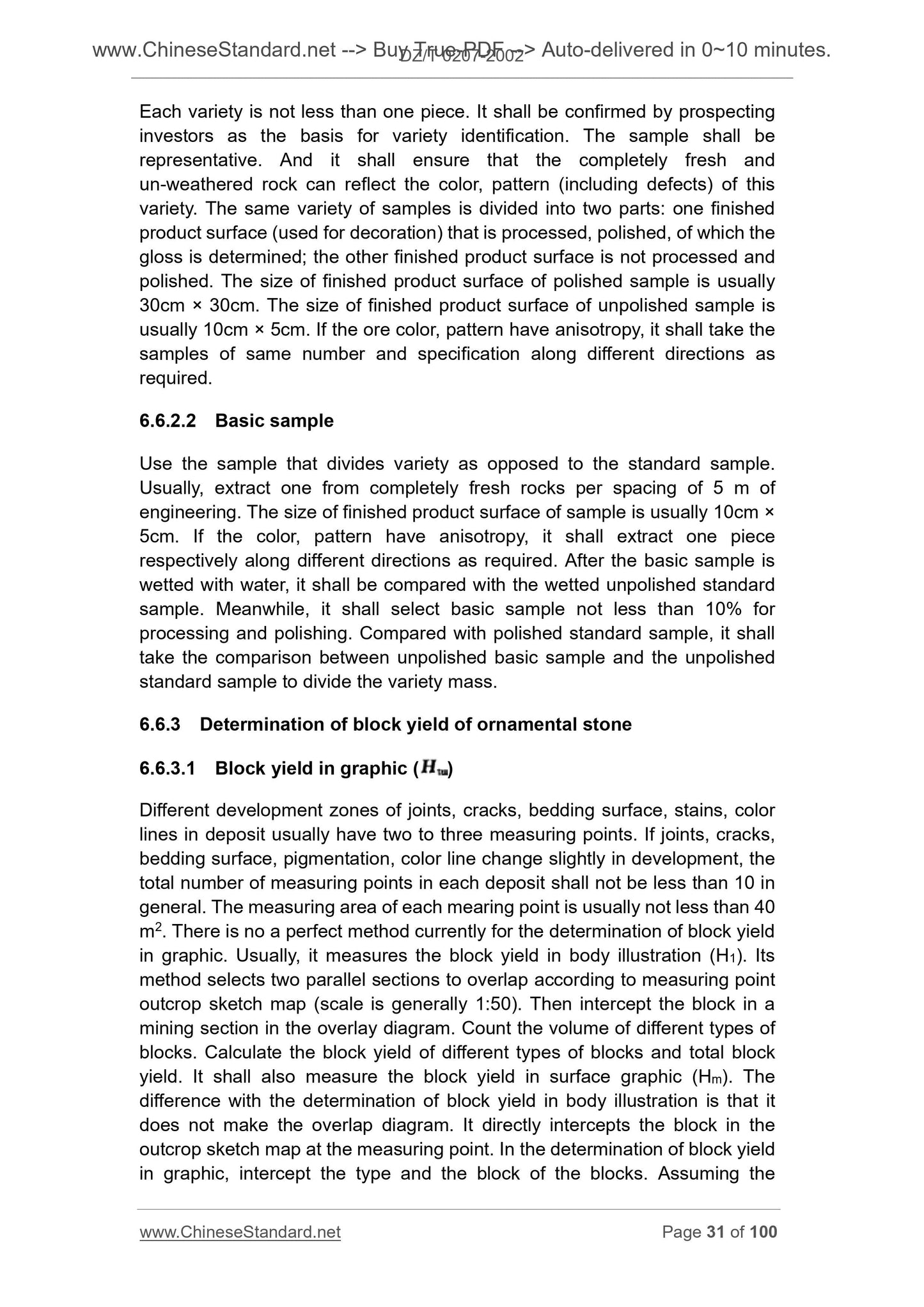1
/
of
12
PayPal, credit cards. Download editable-PDF & invoice In 1 second!
DZ/T 0207-2002 English PDF (DZT0207-2002)
DZ/T 0207-2002 English PDF (DZT0207-2002)
Regular price
$590.00 USD
Regular price
Sale price
$590.00 USD
Unit price
/
per
Shipping calculated at checkout.
Couldn't load pickup availability
Delivery: 3 seconds. Download true-PDF + Invoice.
Get QUOTATION in 1-minute: Click DZ/T 0207-2002
Historical versions: DZ/T 0207-2002
Preview True-PDF (Reload/Scroll if blank)
DZ/T 0207-2002: Specifications for glass-grade silicon materials, ornamental stone, gypsum, chrysotile asbestos, wollastonite talc and graphite exploration
DZ/T 0207-2002
DZ
GEOLOGICAL AND MINERAL INDUSTRY STANDARD
OF THE PEOPLE’S REPUBLIC OF CHINA
ICS 73.020;73·080
D 13
Specifications for glass-grade silicon materials,
ornamental stone, gypsum, chrysotile asbestos,
wollastonite, talc and graphite exploration
ISSUED ON. DECEMBER 17, 2002
IMPLEMENTED ON. MARCH 1, 2003
Issued by. Ministry of Land and Resources of the People’s Republic of
China
3. No action is required - Full-copy of this standard will be automatically and
immediately delivered to your EMAIL address in 0~60 minutes.
Table of Contents
Foreword ... 4
1 Scope ... 5
2 Normative references ... 5
3 Exploration purpose and mission ... 6
4 Exploration research level ... 7
5 Exploration control level ... 18
6 Exploration and mass requirements ... 20
7 Feasibility evaluation ... 40
8 Mineral resources / reserves classification and type conditions ... 41
9 Mineral resources / reserves estimation ... 48
Annex A (normative) Solid mineral resources / reserves classification ... 53
Annex B (normative) Classification standard for mineral resources / reserves
scale ... 54
Annex C (normative) Radiation protection classification control standards of
natural stone products and pre-evaluation of radioactivity levels in deposit
exploration of ornamental stone ... 55
Annex D (normative) Allowable limit of rock mineral chemical analysis
inspection and system error determination ... 58
Annex E (informative) Exploration type classification and exploration engineer
spacing ... 60
Annex F (informative) Drilling coring rules for longitudinal fiber asbestos ... 65
Annex G (informative) Asbestos ore sample processing methods and
processing operation rules ... 70
Annex H (informative) Mineral general industrial requirements... 78
Specifications for glass-grade silicon materials,
ornamental stone, gypsum, chrysotile asbestos,
wollastonite, talc and graphite exploration
1 Scope
This Standard specifies the exploration and control level, the quality of
exploration work, mineral resources / reserves classification and type
conditions, mineral resources / reserves estimates, and other requirements
for glass-grade silicon materials1, ornamental stone2, gypsum3, chrysotile
asbestos4, wollastonite, talc, graphite. It puts forward the feasibility of the
basic requirements for evaluation, and the types of deposit exploration for
analogy and the general spacing of exploration projects for reference.
This Standard applies to mineral exploration, mineral resources / reserves
estimates, acceptance, review geological exploration report of glass-grade
silicon materials, ornamental stone, gypsum, chrysotile asbestos, wollastonite,
talc, graphite. It can also be used as a basis for evaluation and estimation of
mineral resources / reserves in the transfer, listing, exploration and financing
of mineral exploration and mining of the above-mentioned minerals.
2 Normative references
The provisions in following documents become the provisions of this
Standard through reference in this Standard. For dated references, the
subsequent amendments (excluding corrigendum) or revisions do not apply
to this Standard, however, parties who reach an agreement based on this
Standard are encouraged to study if the latest versions of these documents
are applicable. For undated references, the latest edition of the referenced
document applies.
GB/T 12719-91, Exploration specification of hydrogeology and engineering
geology in mining areas
GB/T 13908-2002, General requirements for solid mineral exploration
1 The glass-grade silicon materials referred in this Standard are mainly used for flat glass commonly used silicon
materials, including quartzite, quartz sandstone, vein quartz and quartz sand.
2 ornamental stone refers to the natural stone which is mainly used for the decoration of interior and exterior
surfaces of buildings. There are mainly two types, that is, marble and granite.
3 Gypsum includes gypsum (CaSO4 • 2H2O and anhydrite (CaSO4).
4 Chrysotile asbestos is also known as serpentine asbestos.
industrial value. When necessary, it circles exploration area for pre-feasibility
studies, mine master plans and mine project proposals. For the deposit that
can directly provide the development and utilization, its processing
beneficiation test level shall reach the design requirements for mine
construction.
Exploration is for a prospecting area that is known to have a deposit of
industrial value or has been through the detailed investigation. By encrypting
various sampling projects, the spacing is sufficient to confirm the continuity of
the ore body. It determines the geological characteristics of the deposit in
detail. It determines the ore body morphology, occurrence, size, spatial
location and ore mass characteristics. It has a detailed identification of ore
mining technical conditions. It performs laboratory flow test or continuous
laboratory expansion test on mineral processing and dressing performance.
When necessary, it shall carry out semi-industrial test for the feasibility study
so as to provide the basis for the design of mine construction.
4 Exploration research level
4.1 Geological research level
4.1.1 Pre-investigation stage
Make a comprehensive collection of regional geological data and mineral
distribution and other relevant information. Research to predict the geology
and tectonics in the area, the distribution of ore spots and prospects of
mineralization. When necessary, select favorable locations to carry out route
geological reconnaissance. Make an analogy with known deposits of similar
geological characteristics. Put forward potential mineralization areas for
further work.
4.1.2 General investigation stage
Fully collect and study regional geological data and mineral distribution.
According to the distribution of prospecting minerals, encircle a detailed
investigation area or look for deposits (spot) found for further work. Make a
general identification on the general investigation area geology and tectonics,
ore-bearing, deposit distribution and prospects of mineralization. For ore
deposits (spots) with further work value, it shall generally find out the
distribution range of ore body, the number of ore bodies, scale, shape,
occurrence, distribution and influence of sandstone, and the factors that affect,
destroy the ore body.
4.1.3 Detailed investigation stage
4.1.3.1 Regional geology research
4.1.4.2 Research on orebody geology
Determine in detail the spatial distribution of ore bodies and their extent.
Identify the scale, shape, occurrence and distribution of the main ore body
and the distribution of the post-ore-bearing faults and magmatic rocks to the
ore body. Find out the contrast sign of the ore body, make it connect rationally
well.
Make a basic identification on the ore body’s oxidation zone, weathering zone
depth and cover thickness and distribution range. And understand its material
composition. Study the effects of weathering (oxidation) on ore mining,
mineral processing and other aspects. Study the karst development,
distribution and destruction of the carbonate ore body.
For ornamental stone, it shall the nature, occurrence, distribution and
regularity of joint fissures and bedding planes in ore bodies, the joint fissures,
the spacing between bedding planes, the joint fissure rate, the aspect ratio
(bars/m); the species, shape, s...
Get QUOTATION in 1-minute: Click DZ/T 0207-2002
Historical versions: DZ/T 0207-2002
Preview True-PDF (Reload/Scroll if blank)
DZ/T 0207-2002: Specifications for glass-grade silicon materials, ornamental stone, gypsum, chrysotile asbestos, wollastonite talc and graphite exploration
DZ/T 0207-2002
DZ
GEOLOGICAL AND MINERAL INDUSTRY STANDARD
OF THE PEOPLE’S REPUBLIC OF CHINA
ICS 73.020;73·080
D 13
Specifications for glass-grade silicon materials,
ornamental stone, gypsum, chrysotile asbestos,
wollastonite, talc and graphite exploration
ISSUED ON. DECEMBER 17, 2002
IMPLEMENTED ON. MARCH 1, 2003
Issued by. Ministry of Land and Resources of the People’s Republic of
China
3. No action is required - Full-copy of this standard will be automatically and
immediately delivered to your EMAIL address in 0~60 minutes.
Table of Contents
Foreword ... 4
1 Scope ... 5
2 Normative references ... 5
3 Exploration purpose and mission ... 6
4 Exploration research level ... 7
5 Exploration control level ... 18
6 Exploration and mass requirements ... 20
7 Feasibility evaluation ... 40
8 Mineral resources / reserves classification and type conditions ... 41
9 Mineral resources / reserves estimation ... 48
Annex A (normative) Solid mineral resources / reserves classification ... 53
Annex B (normative) Classification standard for mineral resources / reserves
scale ... 54
Annex C (normative) Radiation protection classification control standards of
natural stone products and pre-evaluation of radioactivity levels in deposit
exploration of ornamental stone ... 55
Annex D (normative) Allowable limit of rock mineral chemical analysis
inspection and system error determination ... 58
Annex E (informative) Exploration type classification and exploration engineer
spacing ... 60
Annex F (informative) Drilling coring rules for longitudinal fiber asbestos ... 65
Annex G (informative) Asbestos ore sample processing methods and
processing operation rules ... 70
Annex H (informative) Mineral general industrial requirements... 78
Specifications for glass-grade silicon materials,
ornamental stone, gypsum, chrysotile asbestos,
wollastonite, talc and graphite exploration
1 Scope
This Standard specifies the exploration and control level, the quality of
exploration work, mineral resources / reserves classification and type
conditions, mineral resources / reserves estimates, and other requirements
for glass-grade silicon materials1, ornamental stone2, gypsum3, chrysotile
asbestos4, wollastonite, talc, graphite. It puts forward the feasibility of the
basic requirements for evaluation, and the types of deposit exploration for
analogy and the general spacing of exploration projects for reference.
This Standard applies to mineral exploration, mineral resources / reserves
estimates, acceptance, review geological exploration report of glass-grade
silicon materials, ornamental stone, gypsum, chrysotile asbestos, wollastonite,
talc, graphite. It can also be used as a basis for evaluation and estimation of
mineral resources / reserves in the transfer, listing, exploration and financing
of mineral exploration and mining of the above-mentioned minerals.
2 Normative references
The provisions in following documents become the provisions of this
Standard through reference in this Standard. For dated references, the
subsequent amendments (excluding corrigendum) or revisions do not apply
to this Standard, however, parties who reach an agreement based on this
Standard are encouraged to study if the latest versions of these documents
are applicable. For undated references, the latest edition of the referenced
document applies.
GB/T 12719-91, Exploration specification of hydrogeology and engineering
geology in mining areas
GB/T 13908-2002, General requirements for solid mineral exploration
1 The glass-grade silicon materials referred in this Standard are mainly used for flat glass commonly used silicon
materials, including quartzite, quartz sandstone, vein quartz and quartz sand.
2 ornamental stone refers to the natural stone which is mainly used for the decoration of interior and exterior
surfaces of buildings. There are mainly two types, that is, marble and granite.
3 Gypsum includes gypsum (CaSO4 • 2H2O and anhydrite (CaSO4).
4 Chrysotile asbestos is also known as serpentine asbestos.
industrial value. When necessary, it circles exploration area for pre-feasibility
studies, mine master plans and mine project proposals. For the deposit that
can directly provide the development and utilization, its processing
beneficiation test level shall reach the design requirements for mine
construction.
Exploration is for a prospecting area that is known to have a deposit of
industrial value or has been through the detailed investigation. By encrypting
various sampling projects, the spacing is sufficient to confirm the continuity of
the ore body. It determines the geological characteristics of the deposit in
detail. It determines the ore body morphology, occurrence, size, spatial
location and ore mass characteristics. It has a detailed identification of ore
mining technical conditions. It performs laboratory flow test or continuous
laboratory expansion test on mineral processing and dressing performance.
When necessary, it shall carry out semi-industrial test for the feasibility study
so as to provide the basis for the design of mine construction.
4 Exploration research level
4.1 Geological research level
4.1.1 Pre-investigation stage
Make a comprehensive collection of regional geological data and mineral
distribution and other relevant information. Research to predict the geology
and tectonics in the area, the distribution of ore spots and prospects of
mineralization. When necessary, select favorable locations to carry out route
geological reconnaissance. Make an analogy with known deposits of similar
geological characteristics. Put forward potential mineralization areas for
further work.
4.1.2 General investigation stage
Fully collect and study regional geological data and mineral distribution.
According to the distribution of prospecting minerals, encircle a detailed
investigation area or look for deposits (spot) found for further work. Make a
general identification on the general investigation area geology and tectonics,
ore-bearing, deposit distribution and prospects of mineralization. For ore
deposits (spots) with further work value, it shall generally find out the
distribution range of ore body, the number of ore bodies, scale, shape,
occurrence, distribution and influence of sandstone, and the factors that affect,
destroy the ore body.
4.1.3 Detailed investigation stage
4.1.3.1 Regional geology research
4.1.4.2 Research on orebody geology
Determine in detail the spatial distribution of ore bodies and their extent.
Identify the scale, shape, occurrence and distribution of the main ore body
and the distribution of the post-ore-bearing faults and magmatic rocks to the
ore body. Find out the contrast sign of the ore body, make it connect rationally
well.
Make a basic identification on the ore body’s oxidation zone, weathering zone
depth and cover thickness and distribution range. And understand its material
composition. Study the effects of weathering (oxidation) on ore mining,
mineral processing and other aspects. Study the karst development,
distribution and destruction of the carbonate ore body.
For ornamental stone, it shall the nature, occurrence, distribution and
regularity of joint fissures and bedding planes in ore bodies, the joint fissures,
the spacing between bedding planes, the joint fissure rate, the aspect ratio
(bars/m); the species, shape, s...
Share
